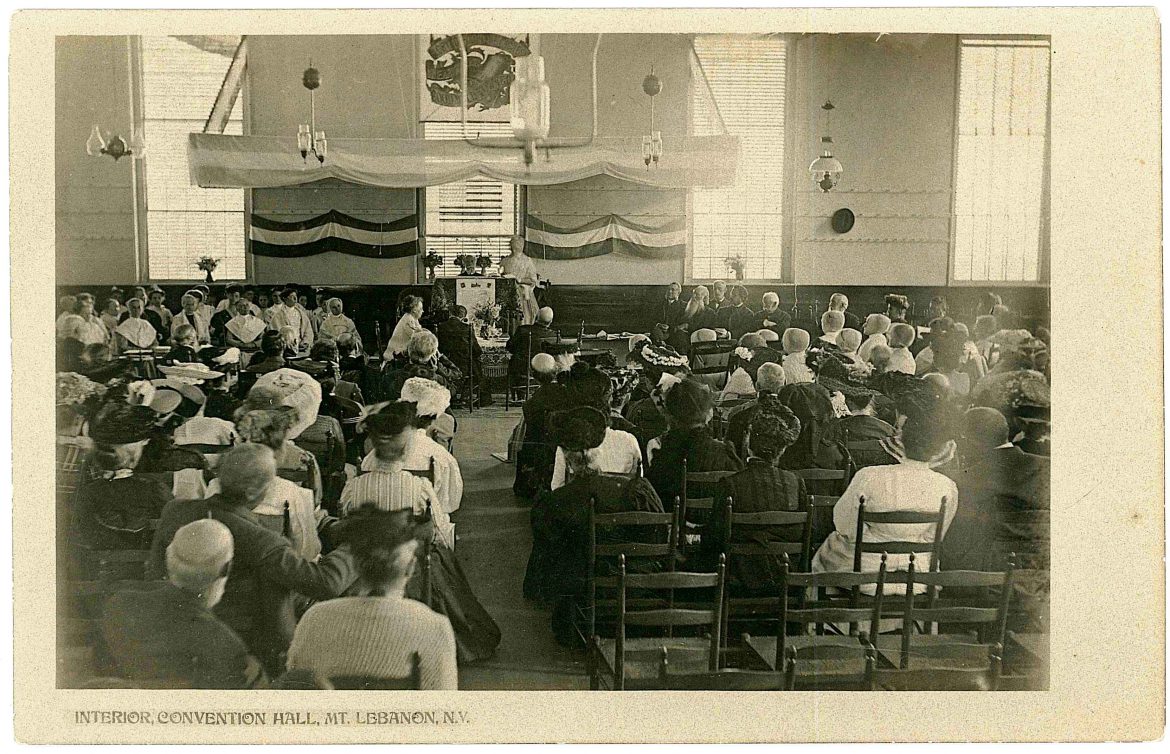
“Interior, Convention Hall, Mt. Lebanon, N. Y.” postcard, Mount Lebanon, NY, 1905-6. 1981.19420.1
On August 31, 1905, the Shakers at Mount Lebanon hosted an international peace convention in their Meetinghouse. For many years the Shakers had been involved in various peace movements in New England, especially the annual gathering supported by the Universal Peace Union at Salt Point, New York. The 1905 meeting focused on three major points: […]
On August 31, 1905, the Shakers at Mount Lebanon hosted an international peace convention in their Meetinghouse. For many years the Shakers had been involved in various peace movements in New England, especially the annual gathering supported by the Universal Peace Union at Salt Point, New York.
The 1905 meeting focused on three major points: First – Arbitration over Armed Conflict; Second – Reduction in Armaments to Reduce the Financial Burden on the Working Classes; and Third – Securing Waterways of Commerce as Neutral Zones. Among the speakers were religious leaders, legal minds, members of the Fourth Estate, and, representing the Shakers, Eldress Anna White of the North Family. The convention coincidentally occurred just at the end of the Russo-Japanese War, which gave those in attendance ample opportunity to praise President Theodore Roosevelt for his work to end that war. A telegram of appreciation was sent to the president from the delegates.

“Interior, Convention Hall, Mt. Lebanon, N. Y.” postcard, Mount Lebanon, NY, 1905-6. 1981.19420.1
The Shakers’ convention is well documented by newspaper articles, broadsides, and a few postcards. The best known image of the convention is of the afternoon session in the sanctuary of the Meetinghouse. It is titled, Interior, Convention Hall, Mt. Lebanon, N. Y. Another image shows carriages assembled in front of the Meetinghouse with people milling around either waiting to enter or having just exited the building. It is titled During Peace Convention, Mt. Lebanon, N. Y.

“During Peace Convention, Mt. Lebanon, N. Y.” postcard, Mount Lebanon, NY, 1905-6. 1981.19404.1
The Museum recently acquired a third postcard produced at the time of the peace convention. This card lacks a caption but clearly shows the interior of the Meetinghouse during the convention.

[Interior, Convention Hall, Mt. Lebanon, N. Y.] postcard, Mount Lebanon, NY, 1905-6. 2016.24191.1
The Shakers themselves vetted the images that were going to be printed as postcards, and it’s possible that since the captioned image shows only a few empty seats in the sanctuary and the uncaptioned card shows many more, the Shakers opted for the image that made the convention appear better attended. The photographer may have hated to waste a perfectly good image, and later decided there was some money to be made by printing the uncaptioned image.
Although the photographer is not identified for certain, it is possible these images were created by James E. West, an itinerant photographer living in Hoosick Falls, New York. West took photographs at both the North and Church Families at Mount Lebanon in the early 1900s and would likely have known about the opportunity to photograph the convention or even have been asked to do so.

[Interior, Convention Hall, Mt. Lebanon, N. Y.] postcard, Mount Lebanon, NY, 1905-6. 2016.24191.1

[Meetinghouse Drive Sheds and Tannery Pond, Mt. Lebanon, N. Y.] postcard, Mount Lebanon, NY, 1905-6. 2013.23578.1